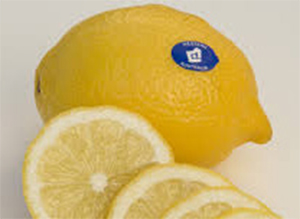This week NAREI in Focus continues to look at principal postharvest diseases that affect lemon crops.
Black Mould
BLACK mould, caused by the soil-borne fungus Aspergillus niger, infects lemons only at fairly high temperatures and only after they have been weakened in some way. External symptoms begin as a soft sunken water-soaked spot on the peel. The spot enlarges and black spores resembling soot appear in the centre. The decay is accompanied by a fermented odour.
 Internal symptoms of black mould include the development of masses of black powdery spores which become obvious mould when the fruit is cut open. Harvesting and handling wounds predispose lemon fruit to infection. The fungus may also invade the peel through cuts in the skin or a stem-end irju.y. Black mould develops rapidly at ambient temperature and spreads to adjacent fruits. In mixed infections, it tends to outgrow other fungi. Control of black mould is obtained by avoiding damage to the peel tissue and storing the fruit at l0″C to 12″C. Decay is insignificant at temperatures below 15oC.
Internal symptoms of black mould include the development of masses of black powdery spores which become obvious mould when the fruit is cut open. Harvesting and handling wounds predispose lemon fruit to infection. The fungus may also invade the peel through cuts in the skin or a stem-end irju.y. Black mould develops rapidly at ambient temperature and spreads to adjacent fruits. In mixed infections, it tends to outgrow other fungi. Control of black mould is obtained by avoiding damage to the peel tissue and storing the fruit at l0″C to 12″C. Decay is insignificant at temperatures below 15oC.
Gray Mould
Gray mould, caused by the fungus Botrytis cinerea, is a common postharvest disease of lemons during cool temperature storage under high humidity. Symptoms appear as a brown leathery decay of the peel, with grey-brown to olive spore masses forming around the affected areas of the fruit surface. The disease spreads readily by contact with adjacent fruit, giving rise to large nests of diseased fruit in packed containers. Optimal temperatures for growth of the fungus are between 18oC to 23″C (64″F to 73’F). However, some growth will also occur at the recommended cool storage temperature. Proper field sanitation, pre-harvest fungicide sprays, and prevention of wounds on the fruit help reduce the incidence of grey mould.
Black Rot
Black rot, caused by the fungus Alternaria citri, is a serious disease in lemons that have been stored for more than one month. The fungus typically enters the fruit through the button and stem-end decay occurs. Lesions developing from infections of the button become light brown to black in colour, and gradually progress over the fruit surface from the blackened button towards the stylar-end. As the button deteriorates during storage, the fungus grows from the surface into the fruit. The pathogen will seldom invade a green button, so it is important to prevent button desiccation.
Entrance of the fungus into the fruit is also aided by mechanical injury or cracks in the peel. Fruit harvested over-mature are more susceptible to black rot. Advanced symptoms of black rot include a blackish-green fungal growth on the fruit surface. Internally, the tissue tums black in the centre of the fruit. The decay does not spread from infected to healthy fruit in packed containers.
Control of black rot is obtained by pre-harvest fungicide sprays to lower the inoculum level, careful harvesting to avoid wounding of the tissue, applying 2,4’D as a 500 ppm dip to delay button senescence, and storage of the fruit at 12″C. Black rot development in lemons can be reduced by a pre-harvest foliar spray of gibberellic acid. Black rot is also retarded by postharvest applications of 2,4-dichlorophenoxy acetic acid at a dose of 500 ppm, which delays senescence of the button.
Control of black rot is obtained by pre-harvest fungicide sprays to lower the inoculum level, careful harvesting to avoid wounding of the tissue, applying 2,4’D as a 500 ppm dip to delay button senescence, and storage of the fruit at 12″C. Black rot development in lemons can be reduced by a pre-harvest foliar spray of gibberellic acid. Black rot is also retarded by postharvest applications of 2,4-dichlorophenoxy acetic acid at a dose of 500 ppm, which delays senescence of the button.
Brown Rot Brown rot, caused by the fungus Phytophthora, is a common postharvest decay of lemons during high amounts of rainfall. Lemons hanging low on the tree are often infected by rain-splashed soil. Winds can then spread the actively growing fungus to fruit in the upper tree. The disease generally occurs during the later stages of fruit development. Symptoms of brown rot appear as a light brown discolouration of the peel (Figure 9). The affected area is firm and leathery.
A white fungal growth develops on the peel during humid conditions. Infected fruit have a pungent, rancid odour, which distinguishes this disease from other rots. Control of brown rot is obtained by a combination of field sanitation, pre-harvest sprays of copper or fosetyl-Al (Aliette) fungicides, disinfection of the harvest containers, and wash water sanitation. Holding green lemons at 12″C and yellow lemons at 10oC will significantly retard the development of brown rot.
Immersion of the fruit in a hot-water bath at 46oc to 48’c (115″F to120″F) for 2 to 4 minutes kills the fungus provided it is confined to external layers of the rind. Fungus that has penetrated well below the rind will survive the heat treatment. Turgid lemons may be injured by the heat treatment and should be allowed to wilt for 1 or 2 days before treatment.




.jpg)










